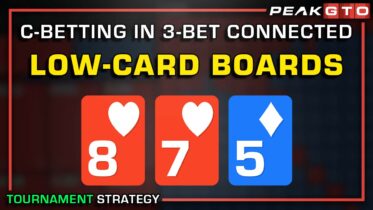The best place to start when it comes to studying cash games is by improving your preflop strategy. You can’t expect to be successful on the flop, turn, and river if you make major blunders at the start of the hand. Knowing what variables to consider and what hands to play from what positions will set you up for success on the felt.
Preflop Strategy: Starting Hands
The Best Starting Hands To Play Preflop
Naturally, having a solid preflop poker strategy starts with good hand selection. To win money at the poker table, you have to play the right hands in the right spots! The best starting hands can be broken down into six categories: big pocket pairs (K♣-K♠), strong big cards (A♣-Q♠), medium pocket pairs (8♣-8♦), suited aces (A♦-8♦), suited connectors (8♠-7♠), and weak pocket pairs (3♣-3♦). These hands have the most potential when it comes to making strong hands like good pairs, flushes, straights, or sets (three of a kind). As long as they are suited, you can also include suited gappers like J-9 in your starting range as they can also make some strong hands.
Although you should include these hands in your starting range, you should not play each of these hands every time you are dealt them. Even though A-10 is a strong hand worth raising preflop, if there is a lot of betting before your turn to act, you are better off folding.
The Worst Starting Hands To Play Preflop
Now that you know what hands you should be playing, what hands should you avoid playing preflop? The worst starting hands can be broken down into four categories: junky connected cards (8♣-6♠), junky suited cards (J♦-3♦), big card-little card (Q♣-2♠), and unconnected low cards (8♣-2♥).
Out of these “bad” hand variations, many players insist on playing junky connected cards for their straight potential. While these cards can make straights, they won’t appear that often. More often than not, when you play junky connected cards you will hit a pair with a bad kicker and have to play a marginal spot. You want to avoid having to play tough spots, especially against tough opponents. By folding your junky hands you will avoid having to play unnecessary spots that put your stack at risk.
Much like junky connected cards, many recreational poker players will play any suited combo because of the flush potential. While you will hit some flushes, your weak flushes will always be vulnerable to the better flushes in your opponents’ range. Rather than trying to get a read on your opponent to figure out if your 7-high flush is good, muck your junky suited cards and hold out for suited aces and kings.
Properly Assessing Preflop Hand Strength
One thing that confuses some poker players is that they have a difficult time understanding hand rankings. Novice poker players will get it in their minds that some hands are “always better” than other ones. Even though pocket aces will always be a stronger hand than 7-2 offsuit, realize hand values change depending on variables like board texture and how many players are in the hand.

Taking a hand like A-K offsuit and running it through Equilab against pocket twos all-in preflop, you will see that despite A-K offsuit being more of a “premium” hand than pocket twos, it still has slightly less equity (or odds of winning) than 2-2 since A-K is unpaired.

Now instead of pocket twos facing A-K offsuit, how does the same hand fair against J-10 suited? It may come as a surprise, but J-10 suited is nearly a 6% favorite over pocket twos. J-10 suited has more strength facing pocket twos as it can make more straights, flushes, and can still hit a better pair to beat two’s.

Taking these three hands a step further, despite A-K offsuit only having a 47% chance of beating pocket twos, it has a 59% chance of defeating J-10 suited. Being able to break down and comprehend the intricacies of hand strength starts with proper study through programs like Equilab.
Some hands will be stronger in some scenarios as opposed to others, while some drawing hands play well when a player is deep stacked, the shorter the stack the less often you should play drawing hands. On the flip side, small pocket pairs are much stronger the shorter your effective stack size becomes.
Don’t get it stuck in your head that because some hands are always better than others, you should always play certain hands and fold others. Poker is a complicated game, but if you stay committed to playing strong hands and maintaining the right ranges, you will be successful in the long run.
The Three Main Reasons To Bet Preflop
Value Betting Preflop And Postflop
There will be spots where you have a strong hand and want to execute a bet that draws a call from your opponents. These bets are for value, and are therefore referred to as value bets. If you have a strong chance of winning the hand, making value bets adds money to a pot that will likely come your way.
Whenever you make a value bet, you want to use a size that has a high likelihood of being called by worse hands. When your value bets are called you likely still have the best hand, but it is important to still consider your opponent’s range and what hands they may be calling with.
The hands you make value bets with range from premium hands (the nuts) and decent but marginal hands. When you bet with a decent, marginal hand, often you do so for thin value. A common thin value spot would be if you had A-Q offsuit and reraised your opponent’s initial raise preflop. When your opponent calls your reraise, you have successfully added value (thinly) to the pot.
Protection Betting Preflop And Postflop
Despite being a broad area of poker strategy, betting for protection is a critical concept worth including in your postflop strategy. With a hand like top pair-bad kicker, you do not mind it when you bet and your opponents fold, as your hand may have been vulnerable to being outdrawn on the turn and river. Inducing such folds with vulnerable hands demonstrates betting for protection, while this does not result in taking down major pots, scooping small pots still provides you with consistent profit.
Bluffing Preflop And Postflop
Sometimes when you bet you will be doing so to bluff and induce your opponents into folding better hands. Before the flop, the hands at the bottom of your betting range are essentially bluff hands.
Whenever you are bluffing, it can either be a pure bluff or a semi-bluff. When you execute a pure bluff, you do so with a hand that has no chance of winning. Pure bluff bets usually occur on the river when there are no more community cards to help you improve to a better hand.
Differing from a pure bluff is the semi-bluff. While a semi-bluff is still a form of a bluff, semi-bluff hands often have huge potential to improve. If you three-bet your opponent’s preflop raise with 8♠-7♠ and get called, while you are likely behind their hand initially, your hand has great flop potential and may be the best hand by showdown. Better yet, if you three-bet with 8♠-7♠ and get your opponent to fold, you just won the pot with a weaker hand.
How To Use A Preflop Hand Ranking Chart
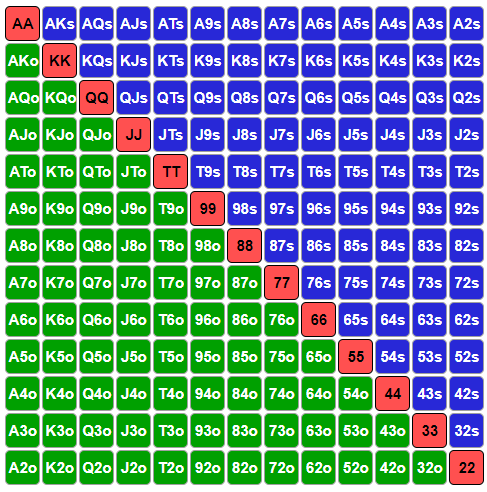
Above is a poker hand ranking chart, something essential to anyone looking to study poker. To effectively study hand charts, it is important you know how to read them.
The above chart is marked as follows: pairs in red, off-suit hands in green, and suited hands in blue. Note that your strongest hands will always be in the top left quadrant, with pocket aces nestled right in the top-left corner.
When Everyone Folds To You Preflop
When everyone folds to you preflop and you are deciding what action to take, it is important to recognize you are not playing a specific hand, but a range. Even though you may look down at Q♦-J♦ and elect to raise, you would also raise with other hands like K♦-J♦ and J♦-10♦ as well. If you would play all of these hands in the same matter preflop, your opponents must consider you may have all of these holdings.
By representing a range instead of just a specific hand, you are much harder to play against. Playing proper ranges and having the ability to represent numerous hands will cause your opponent to make mistakes, and when your opponents make mistakes, you make money.
Although you have your own range, it is important to consider the range of your opponents as well. Do not put your opponents on exactly one hand, as not only will you be wrong the majority of the time, but that’s simply not how poker works!
Even though you may see lots of players limping in low stakes games at your local casino, it is not something you want to emulate. When everyone folds and you decide to enter the hand, always do so with a raise and never limp. When you limp, not only do you allow the big blind to see the flop for free, but you let your opponents see the flop for the minimum. Even if you have pocket aces, the more opponents that stay in the hand means the higher chance your aces get cracked. Make your life easier by only raising or folding.
When choosing your raise sizing, raise three big blinds when your effective stack is over 50 big blinds and raise 2.5 big blinds when you have less than 50 big blinds. Although you can use more specific sizing besides 3x and 2.5x, this general rule is a fine starting point if you are new to poker.
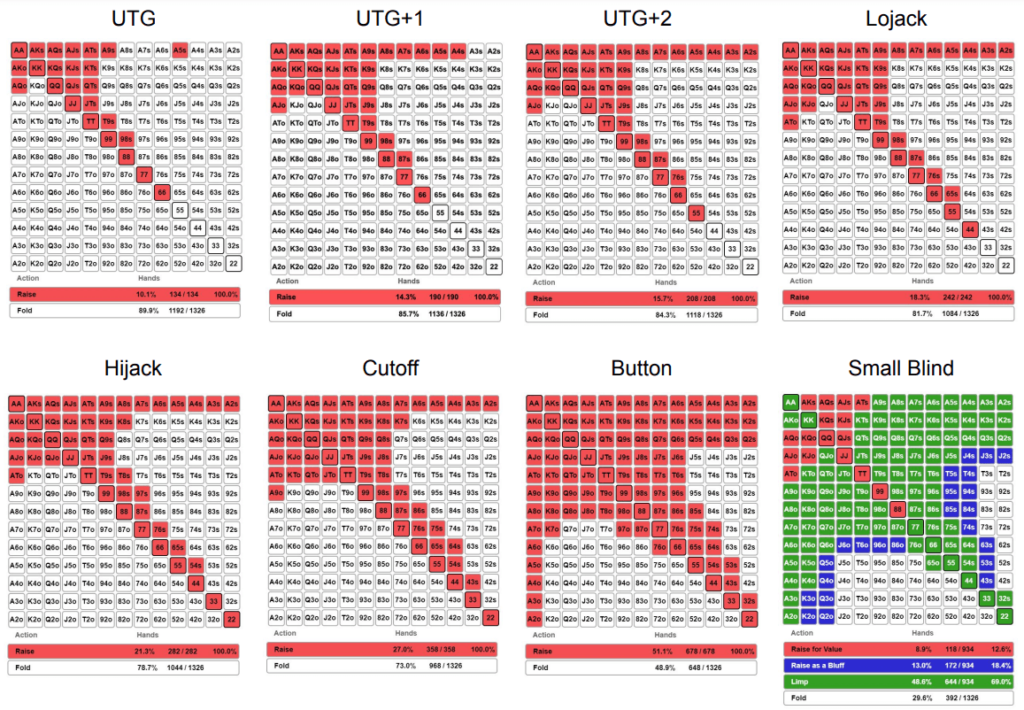
The above charts represent every single position in which you may be first to act/folded to. Notice that the later your position, the more hands you get to raise with. While the under-the-gun (UTG) player only raises with the very best hands, the player on the button raises with the majority of hands. When you only have to worry about two opponents out of position (as the button does), you get to raise with a wide range.
The widening of your range in later positions is a result of not only having more information, but also having to worry about less opponents who have yet to act. Having position on your opponents is one of the strongest edges you can have in a poker hand. The later your position, the better your advantage.
If you are new to poker and simply follow these charts, you will have a natural edge at the poker table. Do not worry about memorizing every single hand within every single chart, as long as you have a general idea of what your raising range should be in each position, you will do just fine.
Everyone Folds To You Preflop In The Small Blind
While it won’t happen often if you play in small stakes cash games, every once in awhile you will be in the small blind and it will fold around to you. The small blind is a unique position, as you are already committed with half of a blind. The chart below represents the small blind’s range when first to act.
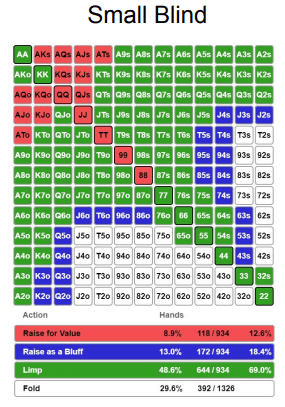
This range assumes the big blind is a strong player. While this is a good, standard small blind range to maintain, be sure you are adjusting to what your opponents do incorrectly at the table.
If it folds around to you in the small blind and you know the big blind only plays the best hands, adjust by raising with any two cards. Since the big blind will overfold, you can steal their blinds and avoid having to play hands out of position by constantly raising.
Let’s say it folds around to you in the small blind, but instead of being overly tight, your opponent is extremely aggressive and has a tendency to three-bet. In that case, you would tighten up your range and only raise with hands that don’t mind calling a three-bet.
Limping From The Small Blind Preflop
Since you only have to pay another half a blind to play, the small blind is the one position where you can have a limping range. Whenever you are offered a discount to enter the hand, it allows you to play with a very wide range.
While you still raise from the small blind with a number of premium hands, your best premium hands like pocket aces and A-K limp from the small blind rather than raise. Limping with your best premium hands allows you to balance your range and prevents the big blind from bullying you. A big mistake some poker players make is always raising with their best hands and always folding their garbage hands, playing this way makes you incredibly easy to play against and should be avoided.
When You Get Three-Bet By An Opponent Preflop
Sometimes when you raise preflop, a player yet to act will decide to reraise (three-bet) you. When you are three-bet preflop, there are a number of variables you must consider.
Your Opponent’s Preflop Three-Betting Strategy
The first thing you should consider is what your opponent’s three-betting range looks like. Putting your opponents on a three-betting range requires you to pay attention to the action, even if you aren’t in the hand.
If you have been playing for hours and an opponent three-bets preflop for the first time, they probably have a strong, premium hand. Unless you have a strong, premium hand yourself, it is probably best you fold because they likely have you crushed!
Instead of a tight player who rarely three-bets, let’s say you are three-bet by an action player capable of bluffing. If you know they three-bet with a wide range, in turn, you should call with a wider range.
What Your Three-Bet Sizing Should Be Preflop
When considering what to do in response to a three-bet, the size of the three-bet should influence whether or not you call. If you raise $6 in a $1/$2 cash game and an opponent three-bets you $12, you should call with a wide range as they are offering you great odds to continue.
Alternatively, if you raise $6 and your opponent makes it $40, you should fold the majority of your range as you are getting much worse odds to call.
What Is Your Position Preflop?
The later position you are when you are three-bet, the wider your calling range should be. Good, strong opponents will know that the later your position, the wider your raising range will be. If your opponents are capable of three-betting you with a wide range, you should call with a wider range from late position. If you raise a hand like A-J offsuit from early position and are three-bet by an opponent, you should consider folding as your opponent is willing to three-bet into your tighter range. If you raise A-J offsuit from late position and get three-bet, you are in a much better position to call.
What Is Your Opponent’s Position Preflop?
While your position is important to consider, also consider the position of your opponent when they three-bet. If you elect to call, which one of you gets to play postflop in-position? Playing postflop in-position gives you a huge advantage over your opponent, if you know you will have positional advantage, call three-bets with a wider range.
When playing in-position, you want to do more calling than raising to keep your opponent in the hand. If you have a strong hand and know they will keep firing, you should call to keep them around and let them add more money to the pot.
Playing out of position, you would much rather raise and get your money into the pot as it is harder to play out of position. Sometimes you will be at risk of losing your stack when your opponent happens to have the nuts, but you would much rather take that risk than play a tough hand out of position.
Playing From The Cutoff Facing A Preflop Three-Bet From The Button
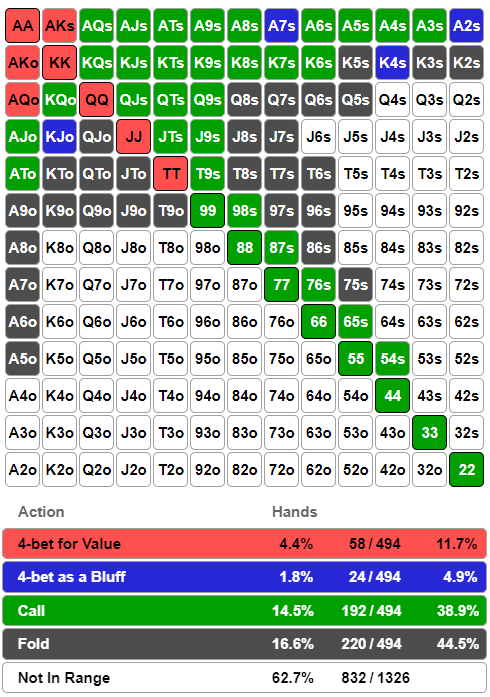
When your cutoff raise gets three-bet by a good, strong opponent on the button, you should four-bet for value with your best hands while maintaining a few four-bet bluffing hands. Often players make the mistake of only four-betting with their best hands, which makes them easy to play against. Keeping some bluffs in your four-betting range makes you harder to play against and helps keep your opponent guessing.
The best hands to four-bet bluff with are hands at the bottom of your calling range that contain a high card. When you have a high card, that is one less high card your opponent can have, decreasing the odds they have a hand like pocket aces or kings.
Despite having four-betting hands, four-bet bluffing hands, and calling hands in your range, you are still folding around 44% of your range. By folding such a large portion of your range and being selective, you avoid having to play out of position as the button will always have position on you.
Playing From The Cutoff Facing A Preflop Three-Bet From The Big Blind

Now let’s say you raise from the cutoff, but instead of facing a three-bet from the button, it’s the big blind who has three-bet you. The main difference between both spots is that in this one, you get to play postflop in-position.
Since you are in-position, not only do you have less four-betting hands in your range, but you also have less four-bet bluffing hands in your range. Four betting less hands helps maintain deeper effective stacks, which you can utilize when making in-position decisions postflop. You make your best decisions when you have the most information, and you never have more information than when you are in-position.
Conclusion
Once you know what hands to play in what positions, playing profitably preflop becomes easy enough if you know what variables to consider. While a lot of your decisions should be based in how your opponents play, the intention of your bets is also an important factor. Whether you are betting for value or to bluff, recognizing the correct spots to do either one starts with making the right preflop decisions. Study the lessons from this article, and you will be well on your way to profitable poker.


